Ladies in Lavender: The Devoted Farmers of the South of France
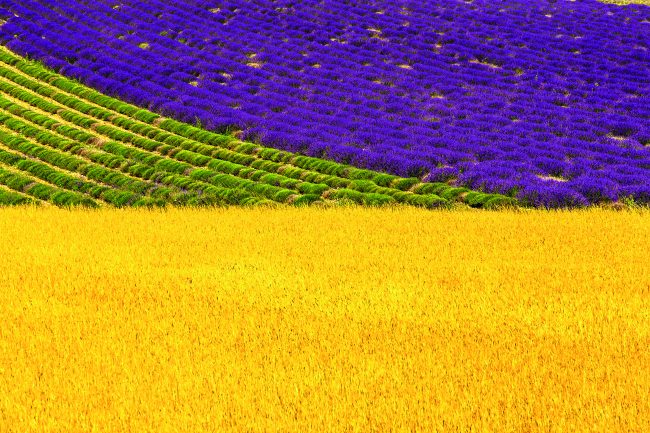
Pests, global warming and fears of extinction haven’t stopped France’s devoted lavender farmers from binding their bouquets year after year. Patrice Bertrand heads to Provence to meet the hardy women keeping this dying art alive
“Every year, at the beginning of July, we go to the fields and start to harvest the lavender. It’s hard because we do it with a sickle, the weather is hot and we are constantly bent over. But this way, the bouquets are almost ready,” explains Marie-José Vidal who, with her Provençal accent, sun-tanned face, cap and overalls, could have stepped straight out of a Jean Giono novel.
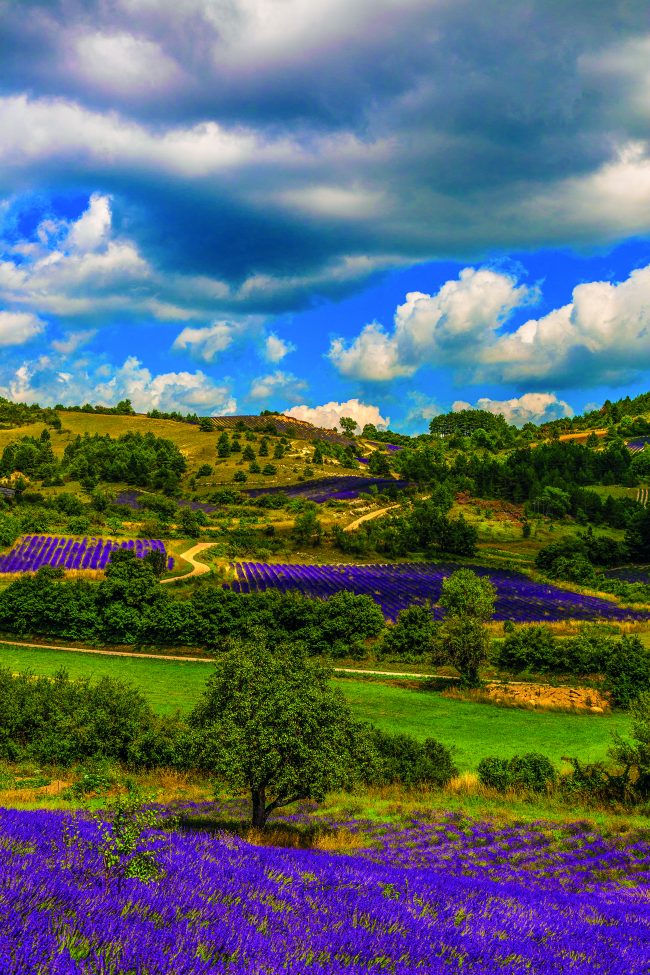
The rolling, purple-pocketed landscape of Mévouillon. Photo: Christophe Constant
A lavender farmer in the tiny village of Mévouillon, at the southern tip of the Drôme département – a place where some of the major centres of French lavender production are located – she practises a relatively uncommon craft: hand-cutting lavender and lavandin (a hybrid lavender) and transforming them into dried bouquets. In growing demand, these beautifully decorated and displayed bunches are found throughout Europe and the United States, most often in flower shops, specialty boutiques or online stores. Simple in appearance, with their fragrant blue heads and long, dry stems, they are perfect for interior decoration, weddings or creating a Provençal atmosphere.

Hard at work, Marie-José cuts her lavender. Photo: Christophe Constant
But the reality behind their confection is one of work, time, patience and know-how. “I’ve been doing this for 20 years,” says Marie-José. “I cut around 800 bouquets a day, which is a good average because after a few days in a row, we get tired quickly. Before, I was able to cut 900 bouquets a day. Once they are cut, we hang them up to dry, their heads always down and the flowers in the shade so the sun does not make them lose their colour. Once they are dry, after six to 15 days, all that’s left to do is remove the leaves that are on the stems, with a pruner for example, and then they are calibrated at 40, 80 or 100 grams, and we wrap an elastic band around them. Then, we cut the stems to an equal length and put them in boxes to send them to florists or wholesalers.” A labour of love, if ever we’ve heard one.
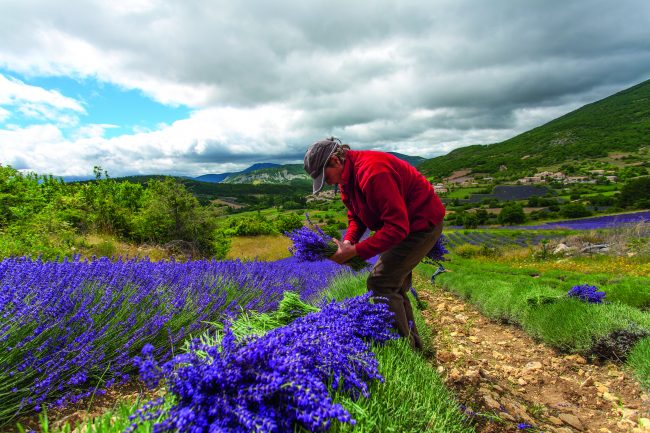
Marie-José Vidal has been in the business for two decades. Photo: Christophe Constant
MAKING THE CUT
Beyond the blood, sweat and tears that go into harvesting, there are also stringent requirements for what makes a marketable end product. “A beautiful bouquet must have long stems of 35-40cm and beautiful blue flowers,” Marie-José explains. “Often, my mother helps me to rearrange the bouquets. It’s a tedious manual job and the movements are repetitive.
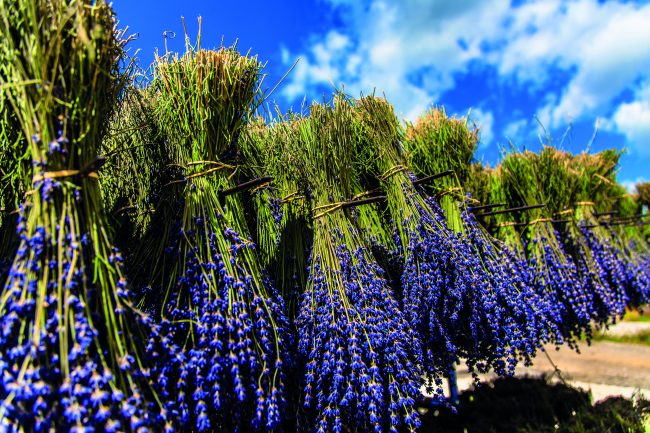
Lavender bouquets. Photo: Christophe Constant
“Before, we used to do it in the winter, but since it’s a stationary activity that we do for five hours, we would freeze. Now I prefer to do it when we are done with all the harvests. I try to finish everything before the end of September but after doing this work, my hands are calloused and I have problems in my wrists. And another thing that is difficult is to keep the land clean because there must not be any grass in the bouquets. So it takes a lot of work before the cutting. We are helped a little by weed killers but sometimes we have to clean by hand.”
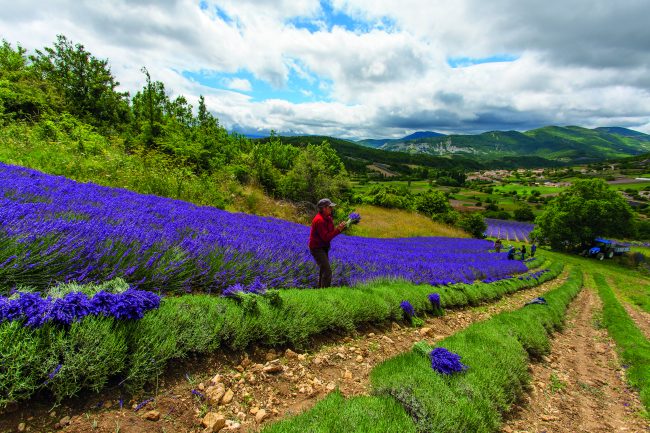
Creating a lavender bouquet. Photo: Christophe Constant
TURNING A PROFIT
According to the Centre Régionalisé Interprofessionnel d’Expérimentation en Plantes à Parfum Aromatiques et Médicinales (or CRIEPPAM – less of a mouthful!), a support centre for lavender producers based in Manosque, bouquet manufacturers like Marie-José are a dying breed. They represent only 5 per cent of all 2,000 lavender growers in Provence, the rest concentrating on the production of flowers and essential oil. With rare exceptions, they are almost all located in the wild hills and high plateaux of southern Drôme and part of the Vaucluse, between 700 and 1,100 metres above sea level. That’s because blue lavender, the variety used to make bouquets, is more vibrant at a higher altitude and doesn’t fade while drying. In addition, the production of bouquets, which is quite profitable, allows farmers to supplement the revenues from the cultivation of fine lavender, from which essential oils are extracted.
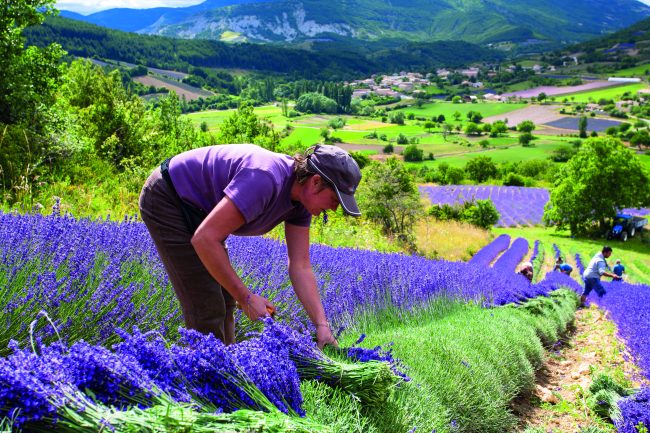
Marie-José cuts her lavender by hand with a sickle. Photo: Christophe Constant
“In total, I have about 60 hectares,” says Marie-José. “Of all this land, the bouquets represent only 10 per cent. But for us it adds value to the small plots of land where we can’t go with the machines because the terrain is too rugged. I also make bouquets of lavandin. They sell for less as they are less beautiful than a bouquet of lavender. Again, we also use a special variety of lavandin, because the one you see everywhere in the fields turns grey once it is dried. And to cut it with a sickle is really difficult because the stems are harder.”
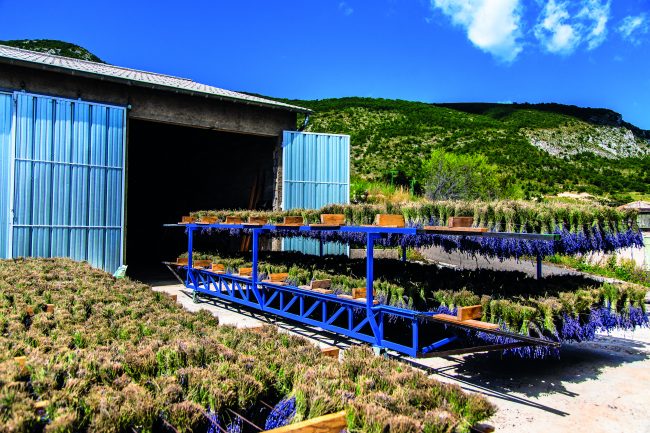
Marie-José and her team produce up to 20,000 bouquets a year. Photo: Christophe Constant
Helped by seasonal workers, a nephew and a cousin, Marie-José manages to produce between 15,000 and 20,000 bouquets a year. But some producers can do a lot more. This is the case, for example, of Nadège Reynard and her husband Johann whose lavender farm, Les Grandes Pourraches, is located in the east of the Vaucluse on the Sault plateau. Swept by the mistral wind in winter and beaten down on by the summer sun, this area offers nothing but arid lands where only lavender, spelt and pasture for goats and sheep grow. There, at the heart of the so-called ‘Blue Country’, they produce about 100,000 bouquets a year.

Nadège Reynard and her husband Johann. Photo: Johann Vervin
BLUE GOLD
“With lavender, you can make essential oil, flowers or bouquets,” explains Nadège. “Since I only have about 60 hectares, the bouquets allow me to make them profitable because it pays a little more than the essential oil. Those who have more hectares do not make bouquets because they manage to make a good living without. On the other hand, there are more constraints: it takes labour and it is expensive.”
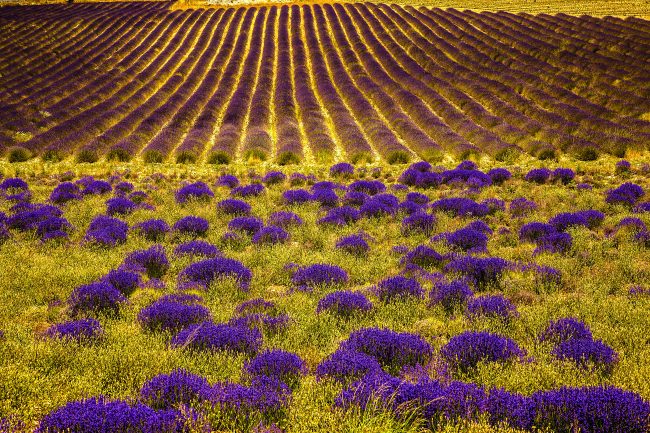
Lavender in the south of France. Photo: Christophe Constant
To solve this problem of profitability, Nadège’s brother, Philippe, found a solution: he invented and manufactured a machine to cut bouquets of lavender from an old carrot harvester. “We’re probably the only ones to do it that way,” admits Nadège. “Even those who make up to 200,000 bouquets a year cut them by hand. But I thought it was too complicated to manage and we opted for this solution. The only drawback is that, initially, they are not as perfectly finished as those cut with a sickle and there are more ‘losses’, or wastage. But when we rearrange the bouquets, we use the ‘losses’ to make dried flowers, so everything works out.”
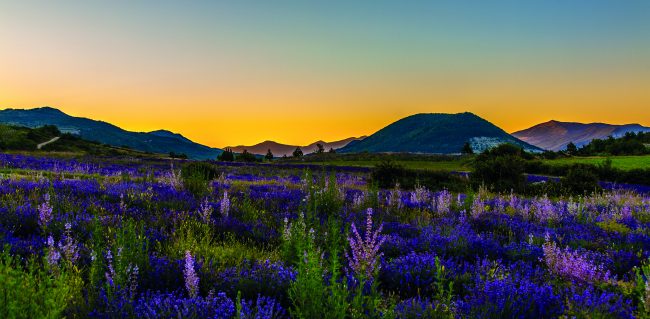
A scene of purple and gold in Drôme Provençale. Photo: Christophe Constant
The harvest complete, Nadège proceeds much like Marie-José, with the odd difference. The bouquets are hung onto wires in a large greenhouse – again, always upside down and out of the sun – but this time, the leaves are removed with a mechanical scraper. Finally, they are calibrated by a machine that wraps elastic bands around the stems.
An employee receives them, checks their weight and carefully places them in boxes for shipping, before they’re whisked away to wholesalers who sell them in Germany, England or Holland. The rest are packaged and sold to souvenir shops.
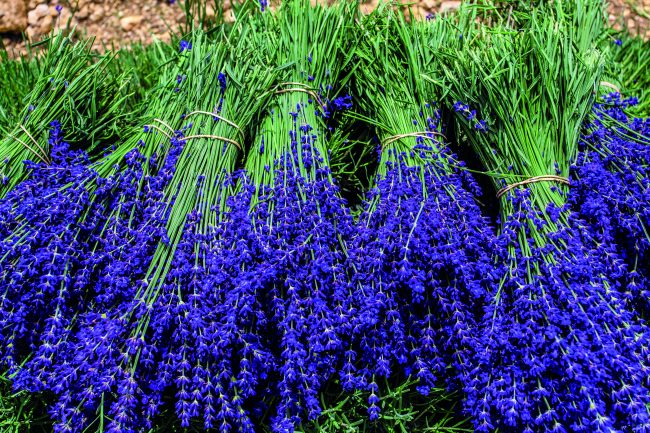
Lavender bouquets. Photo: Christophe Constant
“I sell them very easily now,” enthuses Nadège. Business has certainly picked up compared to just a few years ago, when many feared lavender would be completely wiped out and the traditional craft of bouquets would vanish for good.
In recent years, lavender has faced a triple threat: global warming that has forced farmers to plant in increasingly high altitude sites; the leafhopper, an insect that destroys lavender plants and whose ravages have been amplified by successive droughts and abnormally mild winters; and a new regulation of the European Union, REACH, which classified lavender and lavandin essential oil as a chemical product and provoked an outcry from producers and distillers who questioned the legitimacy of its application to their products. Truly, it’s a bleak thought, to imagine a world without these fragrant beauties.
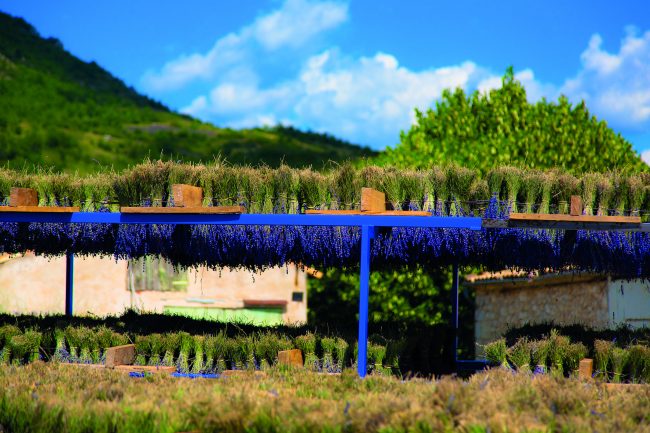
Lavender bouquets hanging upside down. Photo: Christophe Constant
“At one point, it was hard and there was despair and hopelessness,” recalls Marie-José. “I would cry about it all. Today, everything has changed. We sow seeds that are not disease-carrying, we have new selections and the weather is more suitable. Not only does lavender no longer suffer but the lavender market is great. It is exploding on all sides: the flowers, the bouquets and the essential oil; it’s all going well. And lavender and lavandin are now being planted everywhere in France! REACH is still under discussion, but there has apparently been some progress. So morale is good.”
At one time, lavender was nicknamed “blue gold”. Perhaps it will live up to its name once again.
From France Today magazine
Share to: Facebook Twitter LinkedIn Email
More in lavender
Leave a reply
Your email address will not be published. Required fields are marked *


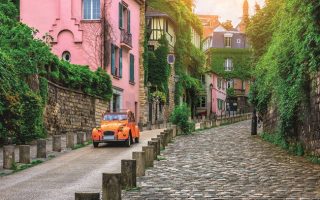
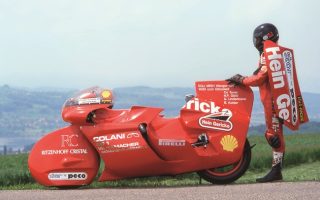
REPLY
REPLY
REPLY
REPLY